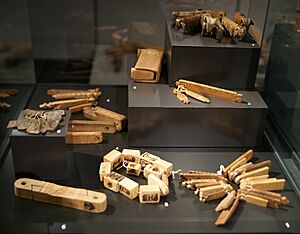Tally stick facts for kids
A tally stick was an old tool used to remember and record numbers, amounts, and messages. People first used tally sticks made from animal bones with cuts on them during the Stone Age. A famous example is the Ishango Bone. Even ancient writers like Pliny the Elder and travelers like Marco Polo wrote about tally sticks. They were used for many things, like sending messages, planning, and especially for money and legal deals. Sometimes, they even worked like money!
Contents
What Are Tally Sticks?

There were two main types of tally sticks: the single tally and the split tally. Both were simple ways to count things. You can see similar counting tools in things like prayer beads.
Ancient Bone Tallies
Scientists believe some very old bones might be early tally sticks:
- The Lebombo bone is about 44,000 years old. It's a baboon bone with 29 cuts. It was found in Eswatini.
- The Wolf bone was found in Czechoslovakia. It's about 30,000 years old. This bone has 55 marks that some think are tally marks.
- The Ishango bone is a dark brown bone tool. It's from around 18,000 to 20,000 BC. It has three rows of possible tally marks carved along its side. It was found in Ishango in Africa.
Single Tally Sticks
A single tally stick was a long piece of bone, ivory, wood, or stone. It had a system of cuts or notches on it. These sticks were mostly used to help people remember things. Other tools like messenger sticks (used by groups like the Inuit) and knotted ropes called quipus (used by the Inca) are similar to single tallies.
Split Tally Sticks
The split tally became popular in Europe during the Middle Ages. Back then, there wasn't much money (coins), and most people couldn't read or write. Split tallies were a perfect way to record deals and debts between two people.
How Split Tallies Worked
A stick, often made of hazelwood, would have cuts made on it. These cuts showed the amount of money or goods. Then, the stick was split lengthwise into two halves. Both halves had the same cuts. Each person in the deal got one half of the stick as proof.
This method was very clever because it was hard to cheat. The two halves of the stick would only fit back together perfectly if they were the original pieces. If someone tried to add more cuts to their half, it wouldn't match the other person's stick.
Stock and Foil
One half of the stick was longer and called the stock. This was given to the person who had given money or items. The shorter part was called the foil. This went to the person who received the money or goods. This way, both people had a clear record of the deal.
Split tallies were accepted as legal proof in courts. Even the Napoleonic Code (a set of French laws from 1804) mentioned them. In some rural areas of Europe, like along the Danube River and in Switzerland, people still used tallies in the 1900s.
Tallies as Money in England
One of the most famous uses of split tally sticks was in England around 1100. King Henry I started using them to record tax payments. But soon, these tally sticks started to be used like money! People would accept them as payment for goods and services. They knew they could later give the tally stick to the government as proof they had paid their taxes.
Eventually, the government even started giving out tally sticks in advance. This was to pay for wars and other royal costs. These sticks then circulated as "wooden money."
How the Exchequer Cut Tallies
The English government's treasury, called the Exchequer, had a special way of cutting tallies:
A cut the size of a hand's palm meant a thousand pounds. A cut the width of a thumb meant a hundred pounds. Twenty pounds was the width of a little finger. A single pound was the width of a swollen barleycorn. A shilling was a bit narrower. A penny was just one cut without removing any wood.
These cuts went all the way across the stick. This made sure that when the stick was split, both halves matched perfectly. Details of the deal were also written on the stick in ink to make it a valid record.
The End of Tally Sticks

The split tally system was used in England for over 700 years, until 1826. In 1834, a huge number of old tally sticks, representing centuries of financial records, were ordered to be burned. They were burned in two furnaces in the Houses of Parliament.
This burning caused a huge fire that spread and destroyed most of the building! This famous event was described by the writer Charles Dickens.
Today, you can see a nod to tally sticks in the design of the entrance gates to The National Archives in Kew, England.
See also
- Bamboo and wooden slips
- Bamboo tally
- Chirograph
- Fu (tally)
- Measuring rod
- Prehistoric numerals

